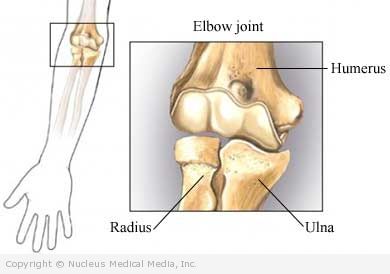(Broken Elbow; Elbow, Broken)
Elbow fracture – Definition
An elbow fracture is a break in one or more of the bones that make up the elbow joint. The bones in the elbow joint are:
- Humerus — the upper arm bone
- Ulna — the larger of the forearm (lower arm) bones
- Radius — the smaller bone in the forearm
Elbow fracture – Causes
This is caused by trauma to the elbow bones. Trauma can be caused by:
- Falling on an outstretched arm
- Falling directly on the elbow
- Experiencing a direct blow to the elbow
- Twisting the elbow beyond the normal range of motion
Elbow fracture – Risk Factors
These factors increase your chance of developing an elbow fracture. Tell your doctor if you have any of these risk factors:
- Advancing age
- Decreased muscle mass
- Osteoporosis (due to menopause or other conditions)
- Playing certain sports (eg, football, hockey, wrestling, gymnastics)
Elbow fracture – Symptoms
Symptoms include:
- Pain, often severe
- Tenderness, swelling, and bruising around the elbow
- Numbness in fingers, hand, or forearm
- Decreased range of motion
- A lump or visible deformity over the fracture site
Elbow fracture – Diagnosis
The doctor will ask about your symptoms, physical activity, and how the injury occurred. The area will be examined.
Tests may include:
- X-rays — a test that uses radiation to take a picture of structures inside the body, especially bones; used to look for a break in the elbow area
- CT scan — a test that uses computers to make pictures of structures inside the elbow; used to look at the cartilage and tendons around the elbow
Elbow fracture – Treatment
Treatment depends on how severe the injury is. Treatment involves:
- Putting the pieces of the bone back in position, which may require anesthesia and/or surgery
- Keeping the pieces together while the bone heals
These devices may be used to hold the bone in place while it heals:
- A cast or splint (may be used with or without surgery)
- A metal plate with screws (requires surgery)
- Screws alone (requires surgery)
Depending on the level of pain, your doctor may prescribe medication.
More x-rays will be done to be sure the bones have not shifted.
Elbow fracture – Exercises
- Start range-of-motion and strengthening exercises.
- Your doctor will tell you when you are ready to start exercising. You may be referred to a physical therapist.
- Do not return to sports until you are completely healed.
Elbow fracture – Healing Time
It takes about 8-10 weeks for a fractured elbow to heal.
Elbow fracture – Prevention
To help prevent elbow fractures:
- Do not put yourself at risk for a trauma to the elbow.
- Eat a diet rich in calcium and vitamin D.
- Build strong muscles to prevent falls and to stay active and agile.

